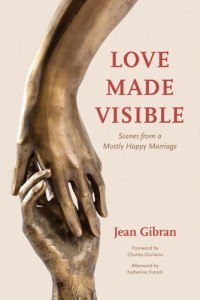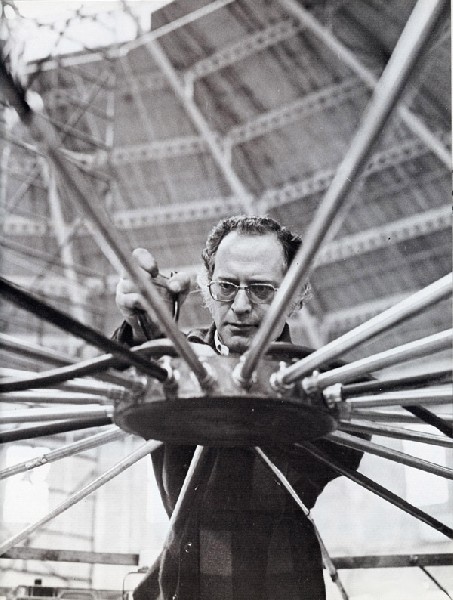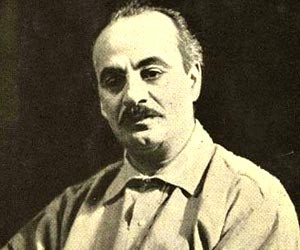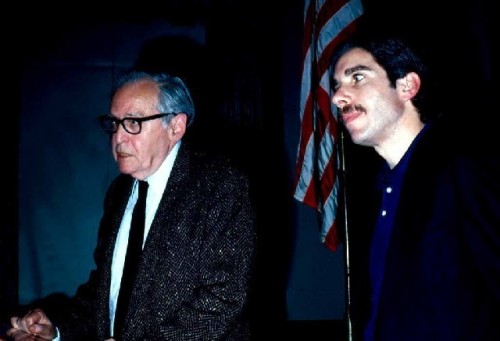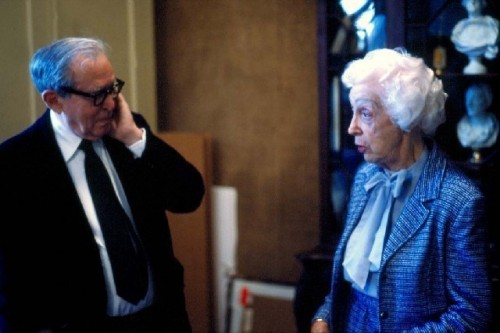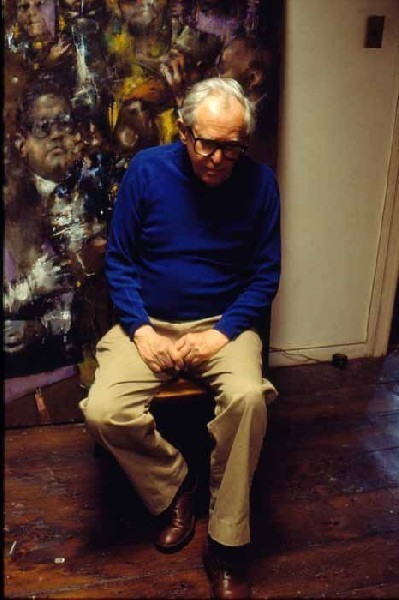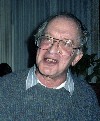Love Made Visible by Jean Gibran
A Complex Book on Her Husband Kahlil Gibran
By: Charles Giuliano - Jul 27, 2014
Love Made Visible: Scenes from a Mostly Happy Marriage
By Jean Gibran
Forew0rd by Charles Giuliano, Afterword by Katherine French
Interlink Books
Northampton, Mass. 01060
Published, 2014
216 Pages, Illustrated with Bibliography, Checklist of works, Selected list of exhibitions, Awards and dedications,`Cast of charaters
ISBN 978-1-56656-978-1, $20.00
A reduced and edited version of this essay was published as the foreword of the book.
In June of 1956, then 16, I visited the Boston Arts Festival installed in a series of tents on the Boston Public Gardens. In particular I was intrigued by a life-sized, welded metal sculpture of “St. John the Baptist” by Kahlil Gibran (November 29, 1922 – April 13, 2008).
In the 1950s The Institute of Contemporary Art was difficult to reach by public transportation on Soldier’s Field Road in Brighton. My effort resulted in an encounter with the first American museum exhibition of the Austrian expressionist Egon Schiele. It was organized by then director, Thomas Messer (February 9, 1920 – May 15, 2013), who in 1961 became director of the Solomon R. Guggenheim Museum in New York.
The ICA and Harvard’s Busch-Reisinger Museum shared the unique legacy of an interest in Northern European and Germanic expressionism. Among artists this would resonate with Jews and sons of immigrants like the Lebanese Gibran who came of age in the 1930s and post war era.
Looking back to the 1950s there were few opportunities to see works by contemporary Boston artists in a museum setting. Despite a young new director, Perry T. Rathbone (July 3, 1911 - Jan. 15th, 2000) , who was intent on making the Museum of Fine Arts more progressive that did not extend to embracing the dominantly Jewish Boston Expressionists.
In the traditional Brahmin arts community there were elements of racism and anti Semitism. That extended to Gibran and his namesake the poet Kahlil Gibran (b. Lebanon 1883-1930) renowned for The Prophet. Assumed to be Islamic the family, which spoke Arabic, was Christian.
The position of the MFA regarding modern and contemporary art was established by the curator of Asiatic art Ananda Kentish Coomaraswamy (22 August 1877 − 9 September 1947). The museum was only interested in deceased artists with established reputations.
When the artist Georgia O’Keeffe presented her friend, Coomaraswamy, with a portfolio of nude photographs of her by her late husband, Alfred Stieglitz, they were accessioned then forgotten. Decades later they resurfaced in a bureau in the museum’s basement.
While Rathbone collected modern European art, particularly Expressionism, he had little interest in Boston Expressionism. To his credit Rathbone exhibited and collected modern art but selectively. One of his final acts while director was the appointment of Kenworth Moffett as curator of contemporary art in 1971.
Commenting on the appointment at the time, former MFA curator of American Art, Theodore E. Stebbins, Jr. said “The MFA is getting into the 20th century now that it is almost over.”
Major works by the leading Boston Expressionists Hyman Bloom (b. BrunavišÄ·i, now part of Latvia, then part of Russian Empire, March 29, 1913, d. Nashua, New Hampshire, United States, August 26, 2009) and Karl Zerbe (b. Germany, September 16, 1903 – November 24, 1972) came to the MFA much later as part of the Lane Collection of American art and photography. Even today the museum owns only a minor work by Jack Levine (b. Boston’s South End January 3, 1915 – d. Manhattan, November 8, 2010). As a teenager with Bloom they were tutored first by Harold Zimmerman at a South End community center and then by Harvard professor, Denman Ross. He collected their juvenilia later donated to the Fogg Art Museum. This unique collection of their early drawings may be seen by appointment but has never been exhibited.
When David Sutherland was making a documentary film on Levine a group of us visited the Fogg. We viewed the drawings and Levine interacted with an old friend, the curator Agnes Mongan.
Other than the occasional Brahmin Boston artist, like Jan Cox of the Museum School, Rathbone had limited interaction with local artists. The post war era represented a period of transition and change for the Boston art world.
In 1986, culminating a series surveying Boston art from Colonial times, the MFA mounted “The Bostonians: Painters of an Elegant Age, 1870-1930” curated by Trevor Fairbrother and Stebbins. There has been no effort for the MFA to provide an update of art in Boston in the decades since then. Other than the Maude Morgan Prize for mid career women artists there is no significant commitment by the museum to exhibit or collect works by Boston’s artists.
When confronted about this lapse now retiring MFA director, Malcom Rogers, stated that the museum’s major commitment to Boston artists focuses on the School of the Museum of Fine Arts. Now and then it has shown its traveling scholars.
Arguably, the 1930s represent a paradigm shift for Boston on every level from social and economic to aesthetic. The faculty and focus of the Museum School progressed from polite and innocuous, ersatz American Impressionism to the more gritty and graphic Boston Expressionism. This transition was largely spearheaded by the teaching of the German émigré Karl Zerbe.
The more traditional and socially acceptable artists showed with the Copley Society or the Guild of Boston Artists. The work of Jews, immigrants or their sons, like the Lebanese/American Gibran, showed with gallerist Boris Mirski or his former assistants Hyman Swetzoff and Alan Fink of Alpha Gallery.
Only in the past few years The Institute of Contemporary Art has begun to collect. Gibran and his peers showed with the ICA, particularly early on like a 1947 Institute of Modern Art (as it was called at the time) group show. Work by the young Gibran was singled out for praise by Boston’s leading art critic, Dorothy Adlow, in the Christian Science Monitor.
The status of Boston in the field of modern and contemporary art would be entirely different if the ICA had collected from its beginning. During the 1950s Messer while director of the ICA advised the MFA on a handful of remarkable acquisitions. There was a plan to merge the ICA with the MFA appointing Messer as its curator. It was deemed by the trustees that the institutions should not compete and Messer left for New York. Another interpretation was that Rathbone wanted control of modern and contemporary art.
The DeCordova Museum and Sculpture Park, in Lincoln has long been dedicated to the artists of New England. There were major surveys “Expressionism in Boston, 1945-1985” “Painting in Boston: 1950-2000 (2002-2003)” and “Photography in Boston: 1955-1985” (2001). While invaluable resources for research these efforts were flawed by flagrant omissions, such as the work of Gibran, and a general lack curatorial acumen.
There were some significant exhibitions organized by the Fuller Museum of Art, in Brockton including the 19th century mystic, “William Rimmer a Yankee Michelangelo” (1986), and retrospectives for Bloom (curated by Dorothy Thompson, 1996), and Henry Schwartz (1990). Several years ago the institution, after years of fiscal struggle, reorganized as the Fuller Craft Museum.
While keeper of prints, drawings and photographs for the Boston Public Library, Sinclair Hitchings, now retired, collected contemporary Boston artists in depth. For a period of time Robert Brown, working out of an office on Beacon Hill, roamed New England gathering papers and conducting oral interviews for the Archives of American Arts in Washington, D.C. The New England branch office was closed through a lack of funding.
More recently Katherine French, director of the Danforth Museum and School, has focused on exhibiting modern and contemporary Boston art. Significantly, Jean and Kahlil Gibran gave the museum 30 works by their friends and peers.
For a youngster just becoming aware of art there was palpable excitement visiting the annual Boston Arts Festival. In addition to exhibiting fine arts there was a stage for live performances. I recall jazz by the renowned Boston baritone sax player, Serge Chaloff, a play by William Saroyan, and a solo ballet performance by Maria Tallchief. The ambitious festival (1955-1962) organized by Nelson Aldrich ended through a lack of funding. An attempt to revive it decades later was embarrassed when the theft of a painting by Barney Rubenstein occurred because of a lack of security.
There were prizes awarded by jurors of the BAF resulting in debates and controversy. This focused on a perceived dichotomy between traditional still life and landscape works and more progressive forms of abstraction. Visitors voted for a Popular Prize.
In 1956 that was awarded to Kahlil Gibran for his memorable “St. John the Baptist.” It stunned and amazed me. With then limited experience it was the greatest work of art I had seen.
Long before my encounters with the illustrations of Vitruvius, dissections of Leonardo da Vinci, or Gray’s Anatomy his sculptures evoked a visceral response. With thin rods following the contours of muscles it was as if Gibran had skinned the prophet the better to reveal suffering and religious ecstasy.
Later I recall seeing the sculpture in front of the Chrysler Museum in Provincetown. In the thick of controversy about forgeries and shady deals Walter Chrysler moved his museum to Norfolk, Virginia. Among other works Gibran’s sculpture was deaccessioned.
So taken by this work, rocked to my inner core, I never imagined that I would come to know the artist. Or eventually write an introduction to a book by his widow Jean English Gibran.
Frankly, it is not the book that I anticipated. As an art historian I expected an orderly, well documented biography. The book might lead to further research of the lost generation of Boston artists. It might be a step toward giving Gibran and his contemporaries their rightful place in the history of post war American art.
There is a perfect storm of reasons why they have languished in a stagnant backwater of provincialism compared to the epic of what Irving Sandler has dubbed “The Triumph of American Art.” There has been no such luck for Boston artists whose efforts in the American art world have signified scattered and Pyrrhic victories.
Early on in the book I found myself accompanying Jean to Mass General and a harrowing account of Kahlil’s death through congestive heart failure. With her I felt numb and traumatized, disoriented by a team of doctors and their frenzied but futile efforts. Was there the possibility that hooked up to machines he would be sustained beyond all quality of life? Were there decisions, do not resuscitate, which in the confusion had slipped by her? How to navigate her confluence of grief and potential guilt? With different and quicker response might he have been saved? These are questions that torment loved ones.
Following that emotional and vivid introduction I anticipated a next chapter which, in the orderly manner of most biographies, would start with childhood and lead us through a chronological study of a career and accomplishments.
Instead we return from the hospital to their home in the South End. It is a monument to his craft and creativity. We follow her contacting family and friends while making arrangements for the funeral. She is coming to grips with the burden and responsibility of the widow of an artist seeing to the archiving, exhibition, research and publication of a lifetime of work.
Jean researched books by the widows of artists. She wondered about her emerging role and identity as the designated keeper of the flame. It is a daunting and exhausting responsibility. Some artists establish foundations and consign works to galleries. Resources are established to enhance the future reputation of the artist and sustainable value of the aesthetic legacy. In many cases heirs seek someone to relieve them of the burden. Even sympathetic museums are reluctant to accept more than a couple of works with marginal market value without an endowment. Then what?
For Jean these concerns were further compounded by the responsibility of not just her husband’s work but also an extensive and valuable archive of paintings, drawings, papers and memorabilia by his namesake/ cousin the Lebanese poet Gibran Kalhil Gibran. Before the sculptor’s death they agreed to transfer the collection to Museo de Soumaya, named for the wife of mogul Carlos Slim Helú. It is a private museum in the Nuevo Polanco area of Mexico City with resources to care for the collection. Mary Haskell, a patron and possible lover of the poet, donated 80 of his works including several paintings and works on paper to the Telfair Museum in Savannah, Georgia. A native of Columbia, South Carolina, she moved from Boston to Savannah when she married Jacob Florance Minis.
Following four years of research and writing in 1974 Jean and Kahlil published "Kahlil Gibran, His Life and World." During that period Kahlil set aside his own work. Living frugally on her income as a teacher, occasional sales of his work, and money from restoration and sales of antiques and artifacts, with what money they had the Gibrans collected works by the poet. Often reclusive, obsessed by work and withdrawn Kahlil, even when he won his first Guggenheim, refused her pleading that they travel. He turned down a potential lead for a Prix de Rome. His exposure to Old Masters was confined to books.
With money from the Guggenheim Foundation, instead of travel or renovation to their home, he purchased cases of Chateux La Tour, St. Emilion, Suduiraut, d’Yquem, and Meursault, Wehlener Sonnenuhr, Bernkasteler Doktor, and Piesporter Goldtropfchen from Berenson’s liquors in Boston. It wasn’t that he was a drinker so much as an opportunity for connoisseurship and self indulgence.
From Jean’s narrative we feel the marital tensions and how he was oblivious to her needs and feelings. We wonder why she remained in a troubled but mostly happy marriage. There is clearly a remarkable bond between Jean and her surgeon daughter Nicole or Nik. Some of the most moving passages in the book occur when, after the funeral, the daughter tries to restore order to her father’s meticulously neat studio. Some precious objects and hand crafted tools were stolen or misplaced.
Jean offers “…a glimpse of everything: the dance master’s pochette with its tortoise shell bridge and ivory head carved from a pool ball, the kangaroo hide wallets, the Matisse-like flowery screen in our precisely constructed black slate prism of a bathroom, the red office desk and accompanying chair, the award-winning hand-hammered squid pot, the ergonomic rolling pin manufactured for maestro drummer Vic Firth’s line of wooden items and drumsticks.”
There is a dual irony. While Kahlil, the artist, won the Popular Prize at the Boston Arts Festival he never enjoyed the critical reputation and institutional support which he deserved. (To be fair he won two Guggenheim fellowships.) Similarly, the poet’s best know work The Prophet has sold multiple millions of copies worldwide in more than 180 languages but earned little respect from literary critics.
Their meticulously researched book strove to document that this is not true. There is an ever growing critical bibliography. A snooty review of their biography in the New Yorker blew it off or damned with faint praise. Jean was hurt and offended while Kahlil opted not to dwell on the insult.
In a poetic and beautifully written memoir Jean reveals that much of this mistreatment is rooted in racism and American paranoia about people of Arabic heritage particularly post 9/11. During an opening in Provincetown a drunken artist poured a beer over Kahlil’s head calling him a “fucking Arab.” There was a similar insult by a New York dealer who wouldn’t show a “fucking Arab” to his largely Jewish clients. The irony is that the Gibrans are Christian while most of his patrons and collectors were Jewish.
Through the first third of the book I resisted what I felt was a widow’s lament and a wife’s screed. I wondered who would read this? What is its intended audience? The artist died in relative obscurity so that comprises a limited audience. Would people of Lebanese/ Syrian heritage be attracted to the book? Both in life and death there is the blessing/ curse of his familiar and famous name. Through a Google search I came up with a lot about the poet and precious little about the artist.
Girding myself to the task I read on. Gradually there was a remarkable and compelling transformation. In a non linear, individualistic, iconoclastic memoir I became absorbed, indeed riveted, as Jean found her own remarkable persona and voice. The final third of the book cascaded over me like an avalanche in the Alps. By her final lines I felt drained and emotionally shattered.
Everything I was looking for was there. It just took patience to let it happen and absorb the insights. Ostensibly it was about Kahlil but really more about Jean and the complex life they shared. In truth the book has a universal audience as it shares the commonality of love, loss and memory.
Jean brought me back to the precious time I spent with them in the South End home that he totally renovated and enhanced with precious craftsmanship. The prize winning squid sauce was served during the dinner we shared in the hand wrought dish he created for it. With a twinkle he related how he had crafted it to sway the judges. Her book reveals how like many starving artists in Provincetown the squid was given to them by fishermen on the docks. They also gathered mussles and clams. Numerous narratives by Provincetown artists attest to the generosity of the Portuguese fishermen.
Holding court for an attentive guest, like many self absorbed artists, Kahlil sucked the oxygen out of the room. He told all the familiar stories like how they paid $9,000 for the South End rooming house now worth a million plus. Jean smiled and listened as usual. It was his show and she didn’t interrupt.
I don’t recall her saying much. At one point a sheet was removed that covered one his greatest works, a life size, erotic, welded sculpture of a woman, legs spread, reclining on a tufted mattress. There was a self conscious awkward exchange as I looked toward her for a response which never came. Kahlil jumped in that Jean was “jealous” of this other woman in his life.
In often painful and brutally honest passages Jean reveals that there was indeed a Galatea in the life of her Pygmalion husband. But she was a more palpable presence and threat than his inanimate muse.
Jean relates coming to accept his profuse apology which stopped me dead in my tracks. There is never a full recovery from such a violation. Particularly from a wife asked to make so many sacrifices for his art. It was less about tarnishing his halo than an honest and real glimpse of what it means to be the dutiful, long suffering wife of a great man. Her narrative is so plain, sincere and understated that it conveys enormous emotional leverage.
As she lays out the details we feel her struggling and grasping with the mixed blessings of a supportive role in the arts. Clearly the work and his obsessions came first. He had little interest in social life beyond an intimate circle of artists, collectors and friends. Holidays and clan gatherings meant little or nothing to him. Like many of the artists of the Boston School there was no interest in celebrity or careerism. There was an almost phobic distrust of critics.
Although, for the most part I get along with artists, there are a few close friends. Jack Levine took pains to tell me how much he hated critics although we actually got along just fine. Through his wife, Stella, Bloom had so many conditions that I declined the opportunity to visit his studio.
Much of the neglect of the Boston Expressionists was of their own making. They retreated to their studios and were more focused on making their work than promoting it. When they did occasionally show in New York the critical response could be brutal.
Reviewing a Bloom show for the New York Times the critic Hilton Kramer wrote it was like “finding gefilte fish at a fashionable party…You can smell the pastrami.” When sculptor Harold Tovish showed at the Guggenheim Kramer destroyed the artist’s career stating that he was “reportedly a big figure on the Boston scene” adding that the work was “tedious, banal” and “egregiously secondhand…the work of a provincial artist.”
In muddled art speak today nobody writes with the malice that was typical of New York critics of Kramer’s generation. On the other hand the Boston critics of that era- Dorothy Adlow, Edgar Driscoll and Robert Taylor- who wrote about Gibran and others were supportive but ranged from insightful to insipid or inept.
From 1940 to 1943 Gibran studied with Zerbe at the School of the Museum of Fine Arts. Zerbe was particularly involved with traditional techniques including the ancient medium of encaustic. That focus on craft was particularly important to Gibran. Students made meticulous copies of the MFA’s early Italian medieval and Renaissance panel paintings with tempera and gold leaf.
Jean reveals that Kahlil was close to Bloom. They shared interests in mysticism and the occult as well as Middle Eastern Music. Kahlil repaired Bloom’s Arabic instruments which he also made in addition to violins. Like Bloom and several other artists Gibran was in therapy for years.
There were many levels of creative and philosophical synergy among Gibran and his peers. But I resist the one size fits all designation of Boston Expressionism. It is too easy and confining. There are so many aspects to the work of Gibran which are outside the margins of Expressionism. Kramer inaccurately lumped them together as illustrative and provincial.
I prefer to think of the work of Gibran as poetic, classical in its canons of beauty, while obsessed with technique and craft. His practice was unique, particularly as rooted in a Lebanese heritage (Arabic was his first language) and craft traditions. It largely falls outside the confines of Boston Expressionism. He ran with the pack but mostly Kahlil functioned as a lone wolf.
There is the enormous challenge of understanding his whimsy and invention. That was entirely unique. No other artist of his circle had that range or versatility.
Once I encountered him on his way to shoot pool. That seemed odd to me. Pulling up a leg of his pants he revealed a crater in his calf muscle where cancer had been removed. The doctor prescribed exercise. That led to pool. He didn’t like the generic sticks. He decided to make his own. I don’t know if it improved his game. But what a metaphor. If you can’t afford a first class pool stick then make one. Necessity fueled by poverty is the mother of invention.
I was surprised by the importance of Provincetown in Jean’s narrative. Particularly that he was present during events of the seminal Forum ’49. Gibran was close to the poet, artist and jazz critic, Weldon Kees, who organized the summer long seminar that examined the development of the New York School and Abstract Expressionism. It meant that Gibran participated in a seminal debate. That level of critical dialogue wasn’t happening in Boston.
I was intrigued by Jean’s book mining it for nuggets of the inadequately appreciated Boston School. There are lots of leads for further research.
This thoughtful, brutally honest and moving book helped me to better know and appreciate my friend Kahlil Gibran. For that experience I am deeply grateful.

